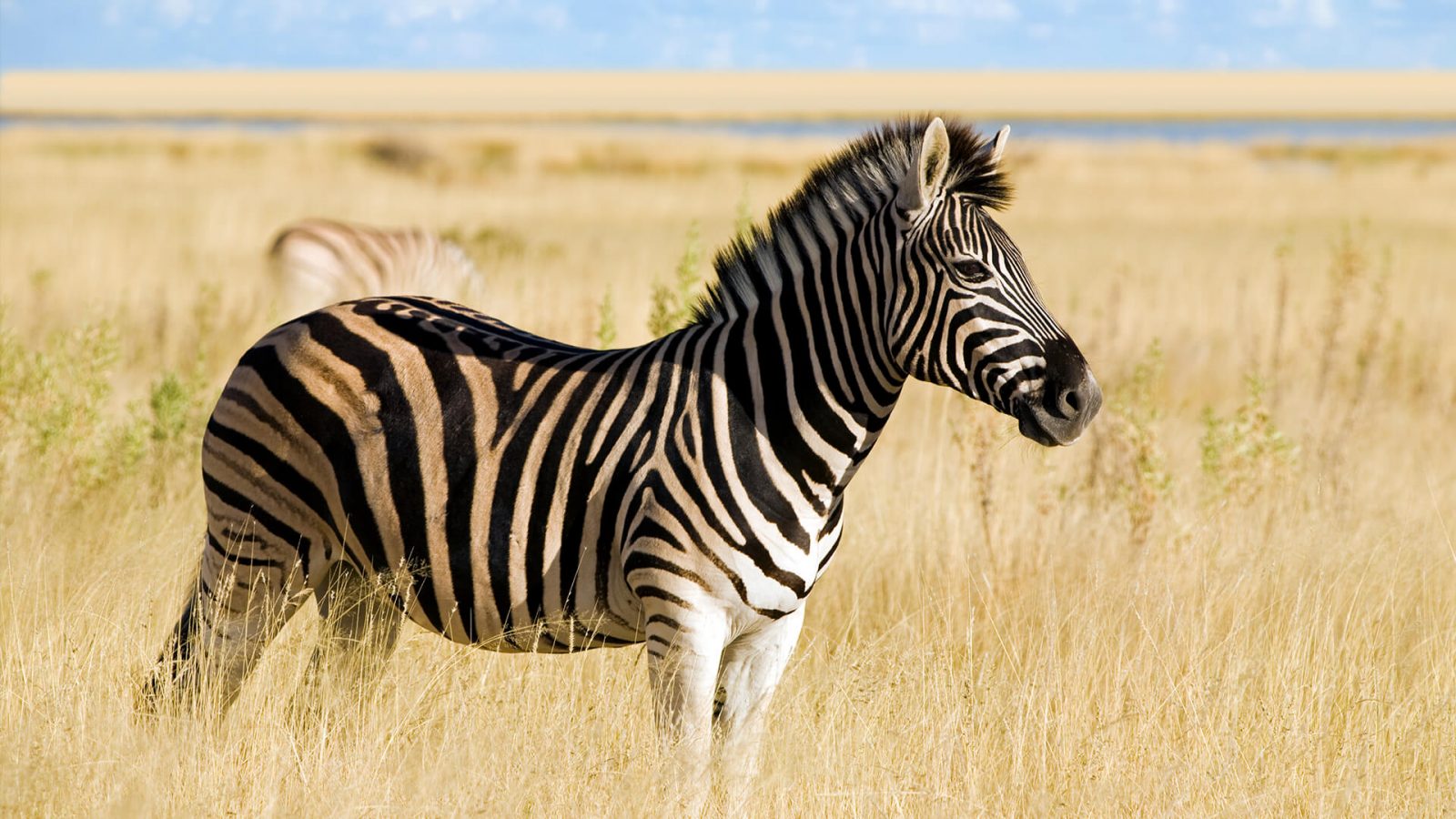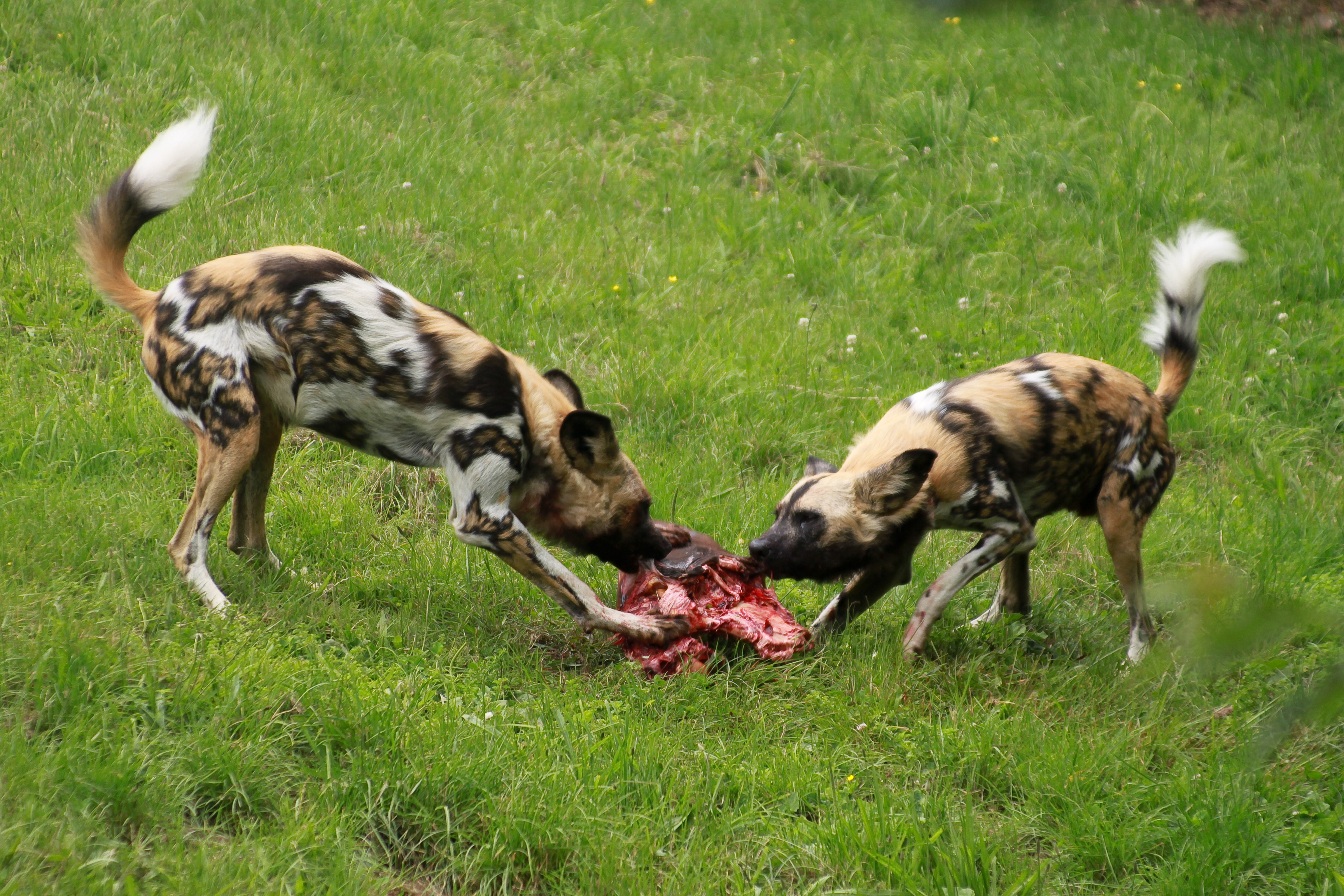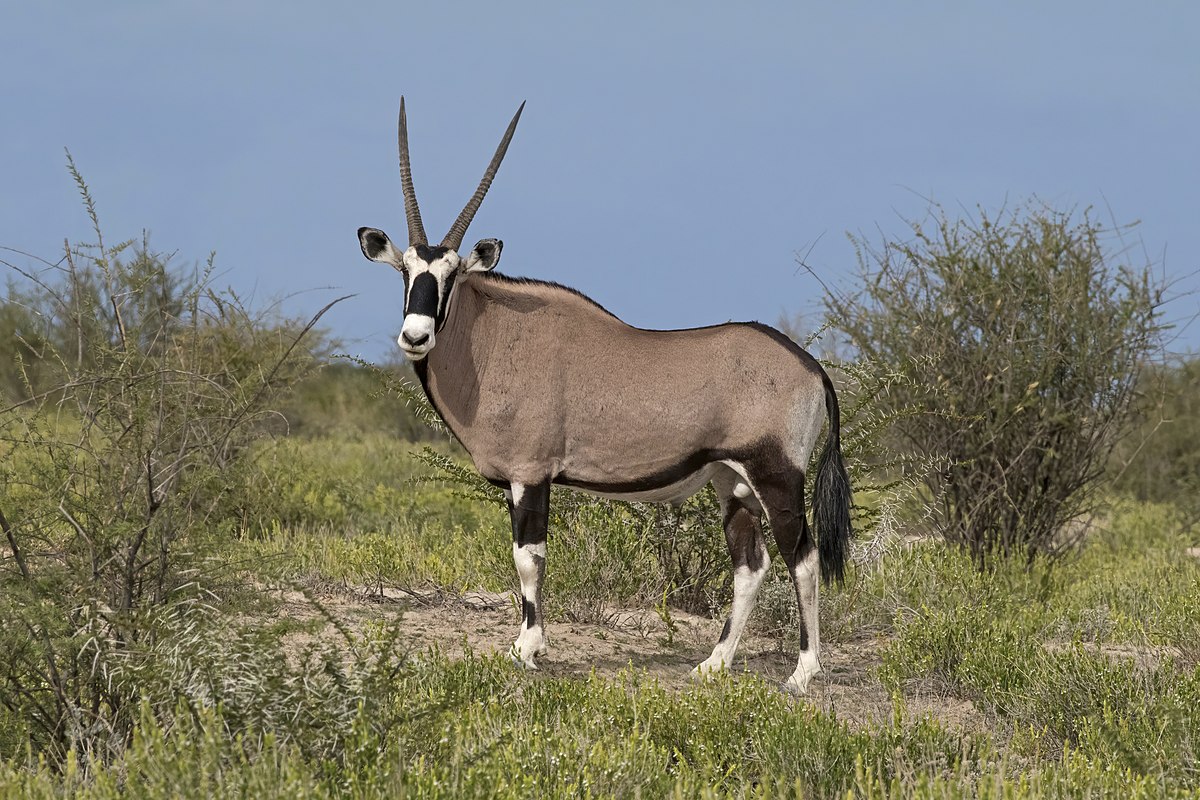Table of Contents
Best 10 Common Animals In Khaudum Park In Botswana
Best 10 common animals in Khaudum park are elephant, giraffe, hippo, zebra, wildebeest, hyena, wild dog, Abdim’s storks, yellow-billed kites, and gemsbok. Khaudum National Park is an isolated Nature Reserve situated in the Kalahari Desert at the west of the Caprivi Strip in northeast of Namibia. It is a very remote and inaccessible reserve but is home to some magnificent animals, such as the lion and hyena. The park also has a campsite for visitors.
The unspoiled nature of the reserve encourages a rich and varied wildlife in the dry forest. The ideal time for seeing wildlife is from June to October. From November to March, more than 320 species of birds inhabit the area, including parrots and more than 50 birds of prey.
Big game can be found in the park occasionally, more than 500 African bush elephants, many Angolan giraffes and many antelope, including roan antelope, kudu, lyre antelope, eland and reed buck. Even the stock of prey animals is high. Besides the smaller cats, there is a larger population of lions, but also leopards, spotted hyenas, jackals, occasionally cheetahs and even African wild dogs.
Since 2005, the protected area is considered a Lion Conservation Unit together with Caprivi Game Park.
Khaudum, though very isolated, does see a large number of tourists every year. Initially, only two camps were open to visitors, but both camps and the whole Park were closed in May 2013. In 2015, the Khaudum campsite was privatized and completely renovated. It now offers 6 shaded camping areas near the Khaudum Lodge.
The Khaudum National Park is situated in the north-east Kalahari biome of Namibia, on the border to Botswana. Initially, Khaudum was established to protect the lifestyle of the San Bushmen who have inhabited the Kalahari Desert for thousands of years. Today, it is the most pristine nature conservation area in Namibia, falling within the Kalahari Sand veld, 3842 sq km in area.
The best 10 common animals in Khaudum park include;
1. Elephants in Khaudum park
Elephants are the largest existing land animals. Three living species are currently recognized: the African bush elephant, the African forest elephant, and the Asian elephant. They are the only surviving members of the family Elephantidae and the order Proboscidea. The order was formerly much more diverse during the Pleistocene, but most species became extinct during the Late Pleistocene epoch.
The trunk is used for breathing, bringing food and water to the mouth, and grasping objects. Tusks, which are derived from the incisor teeth, serve both as weapons and as tools for moving objects and digging. The large ear flaps assist in maintaining a constant body temperature as well as in communication.
African elephants have larger ears and concave backs, whereas Asian elephants have smaller ears, and convex or level backs.In Botswana, there are African elephants and they are about 3,000 elephants that live in the park. These are often seen in groups and herds drinking water or grazing on the grass. This makes them one of the best 10 common animals in Khaudum park.

2. Giraffes in Khaudum park
The giraffe is a large African hoofed mammal with a protruding neck belonging to the genus Giraffa. It is the tallest living terrestrial animal and the largest ruminant on Earth. Traditionally, giraffes were thought to be one species, Giraffa camelopardalis, with nine subspecies. There are other seven extinct species of Giraffa are known from the fossil record. The giraffe’s chief distinguishing characteristics are its extremely long neck and legs, its horn-like ossicones, and its spotted coat patterns.
It is classified under the family Giraffidae, along with its closest extant relative, the okapi. Its scattered range extends from Chad in the north to South Africa in the south, and from Niger in the west to Somalia in the east. Giraffes usually inhabit Savannah grasslands and woodlands. Their food source is leaves, fruits, and flowers of woody plants, primarily acacia species, which they browse at heights most other herbivores cannot reach using their long necks.
These are seen in the park reaching for leaves on the top trees to get food making them one of the best 10 common animals in Khaudum park.

3. Hippopotamuses in Khaudum park
The hippopotamus, also called the hippo, common hippopotamus, or river hippopotamus, is a large semi-aquatic mammal native to sub-Saharan Africa. It is one of only two extant species in the family Hippopotamidae, the other being the pygmy hippopotamus (Choeropsis liberiensis or Hexaprotodon liberiensis). Its name comes from the ancient Greek for “river horse”.
Hippos are recognizable for their barrel-shaped torsos, wide-opening mouths with large canine tusks, nearly hairless bodies, pillar-like legs, and large size, bulls (males) and for cows (females). Despite its stocky shape and short legs, it is capable of running 30 km/h over short distances. Hippos inhabit rivers, lakes, and mangrove swamps. Territorial bulls each preside over a stretch of water and a group of five to thirty cows and calves.
Mating and birth both occur in the water. During the day, hippos remain cool by staying in water or mud, emerging at dusk to graze on grasses. While hippos rest near each other in the water, grazing is a solitary activity and hippos typically do not display territorial behavior on land. Hippos are among the most dangerous animals in the world due to their aggressive and unpredictable nature.
They are threatened by habitat loss and poaching for their meat and ivory (canine teeth). These are always seen near the water shores in the park making them one of the best 10 common animals in Khaudum park.

4. Zebras in Khaudum park
Zebras are African equines with distinctive black-and-white striped coats. There are three living species: the Grévy’s zebra (Equus grevyi), plains zebra (E. quagga), and the mountain zebra (E. zebra). Zebras share the genus Equus with horses and asses, these three groups being the only living members of the family Equidae. Zebra stripes come in different patterns, unique to each individual.
Several theories have been proposed for the function of these stripes, with most evidence supporting them as a deterrent for biting flies. Zebras inhabit eastern and southern Africa and can be found in a variety of habitats such as savannas, grasslands, woodlands, shrub lands, and mountainous areas. And these are seen in the scrud and grasslands grazing in the park making them one of the best 10 common animals in Khaudum park.

5. Wildebeest in Khaudum park
Wildebeest are antelopes of the genus Connochaetes and native to Eastern and Southern Africa. They belong to the family Bovidae, which includes true antelopes, cattle, goats, sheep, and other even-toed horned ungulates. There are two species of wildebeest: the black wildebeest or white-tailed gnu, and the blue wildebeest or brindled gnu. Fossil records suggest these two species diverged about one million years ago, resulting in a northern and a southern species.
The blue wildebeest remained in its original range and changed very little from the ancestral species, while the black wildebeest changed more as adaptation to its open grassland habitat in the south. The most obvious ways of telling the two species apart are the differences in their coloring and in the way their horns are oriented. These are seen in big herds in the grasslands making them one of the best 10 common animals in Khaudum park.

6. Hyena in Khaudum park
Hyenas, or hyaenas (from Ancient Greek), are feliform carnivoran mammals of the family Hyaenidae. With only four extant species (each in its own genus), it is the fifth-smallest family in the Carnivora and one of the smallest in the class Mammalia. Although phylogenetically closer to felines and viverrids, as part of suborder Feliformia, hyenas are behaviorally and morphologically similar to canids in several elements due to convergent evolution; both hyenas and canines are non-arboreal, cursorial hunters that catch prey with their teeth rather than claws.
Despite their low diversity, hyenas are unique and vital components of most African ecosystems. Both eat food quickly and may store it, and their calloused feet with large, blunt, non retractable claws are adapted for running and making sharp turns. However, hyenas’ grooming, scent marking, defecation habits, mating and parental behavior are consistent with the behavior of other feliforms. These are seen in the hilly areas of the park making them one of the best 10 common animals in Khaudum park.

7. Wild dogs in Khaudum park
The African wild dog, also called the painted dog or Cape hunting dog, is a wild canine which is a native species to sub-Saharan Africa. It is the largest wild canine in Africa, and the only extant member of the genus Lycaon, which is distinguished from Canis by dentition highly specialized for a hyper carnivorous diet, and by a lack of dewclaws.
It is estimated that about 6,600 adults (including 1,400 mature individuals) live in 39 sub-populations that are all threatened by habitat fragmentation, human persecution, and outbreaks of disease. As the largest sub-population probably comprises fewer than 250 individuals, the African wild dog has been listed as endangered on the IUCN Red List since 1990. These can also be seen in and around the hilly areas of the park making them one of the best 10 common animals in Khaudum park.

8. Abdim’s storks in Khaudum park
Abdim’s stork (Ciconia abdimii), also known as the white-bellied stork, is a stork belonging to the family Ciconiidae. It is the smallest species of stork, feeds mostly on insects, and is found widely in open habitats in Sub-Saharan Africa and in Yemen. The common name commemorates the Turkish Governor of Wadi Halfa in Sudan, Bey El-Arnaut Abdim (1780–1827).
Abdim’s stork is a black stork with grey legs, red knees and feet, grey bill and white underparts. It has red facial skin in front of the eye and blue skin near the bill in breeding season. It is the smallest species of stork, at 73 cm and a weight of just over 1 kg. The Abdim’s stork is mostly insectivorous, feeding on locusts, caterpillars and other large insects, although these birds will also eat small reptiles, amphibians, mice, crabs and eggs. The female lays two to three eggs and is slightly smaller than the male. These are seen in the scattered trees in the national park making them one of the best 10 common animals in Khaudum park.
![]()
9. Yellow-billed kites in Khaudum park
The yellow-billed kite (Milvus aegyptius) is the Afro tropic counterpart of the black kite (Milvus mi-grans), of which it is most often considered a subspecies. However, recent DNA studies suggest that the yellow-billed kite differs significantly from black kites in the Eurasian clade, and should be considered as a separate, allopatric species.
There are two subspecies: M. a. parasitus, found throughout most of sub-Saharan Africa including Madagascar, except for the Congo Basin with intra-African migrations and M. a. aegyptius of Egypt, south-west Arabia and the Horn of Africa which disperses south during the non-breeding season. Seen on the rosky areas of the park making them one of the best 10 common animals in Khaudum park.

10. Gemsbok in Khaudum park
The gemsbok or South African oryx is a large antelope in the genus Oryx. It is native to the extremely dry, arid regions of Southern Africa; notably, the Kalahari Desert. Some authorities formerly classified the East African oryx, or beisa oryx, as a subspecies. Gemsbok is light taupe to tan in color, with lighter patches toward the bottom rear of the rump. Their tails are long and black in color.
A blackish stripe extends from the chin down the lower edge of the neck, through the juncture of the shoulder and leg along the lower flank of each side to the blackish section of the rear leg. They have muscular necks and shoulders, and their legs have white ‘socks’ with a black patch on the front of both the front legs, and both sexes have long, straight horns.
Comparably, the East African oryx lacks a dark patch at the base of the tail, has less black on the legs (none on the hind-legs), and less black on the lower flanks. One very rare color morph is the “golden oryx”, in which the gemsbok’s black markings are muted and appear to be golden. Seen in the long savanna grasslands of the park making them one of the best 10 common animals in Khaudum park.

When to visit Khaudum park
The park can be visited throughout the year depending on tourists timetables or schedules, but the best moths to visit Khaudum national park in Namibia is between April and September/October which makes up the dry season. This is the season when the birds migratory birds and animals all look for water because of its scarcity and join in one place to all share the water.
How to get to Khaudum national park
Khaudum park is isolated and situated in the Kalahari desert at the west of the Caprivi strip in the northeast of Namibia, it is a very remote and inaccessible park but is home to some magnificent animals. Located 796km northeast of Windhoek. If you are planning to travel by road, you should have a 4×4 vehicle.
The sandy roads are challenging and self drive should only be undertaken by travelers who have a lot of experience with the expeditions. The tours begin in Windhoek. In Windhoek, there is an airport called Hosea Kutako International Airport that you land on after your flight, which is found 40km east of the city.
Accommodation in Khaudum national park
Accommodation in Khaudum national park is based on mainly camping because visitor facilities are not common in the area and if one is willing to live luxuriously, you have to pick a place that is not in the park.
Camps in Khaudum national park
- Onguma Forest camp; The camp provides accommodation, free breakfast, free WiFi, pool activities, air conditioning and others all at a price of USh 1,390,042.
- Nhoma Safari Camp; The camp is a small activity oriented, tented camp of Namibia on communal land of the Ju|’hoan San. Offering restaurant, breakfast and others.
Other accommodations near Khaudum national park
- Kololo Guest house; Set 2.8km from Katima Mulilo, offering restaurant, bar and air conditioning with a patio and free WiFi all at a price of USh 164,992.
- Namushasha River Lodge, Gondwana collection Namibia; Bordering the Namushasha river, this laid back lodge is 12 minute walk from Namushasha heritage center and 48 km from horseshoe viewpoint. Offering services like accommodation, restaurant.
In conclusion
Kubwa Five Safaris is the only one that can make all this happen if at all you are interested in going for a trip similar to this. Given that we are the ones that took the time to gather for you all this information.
